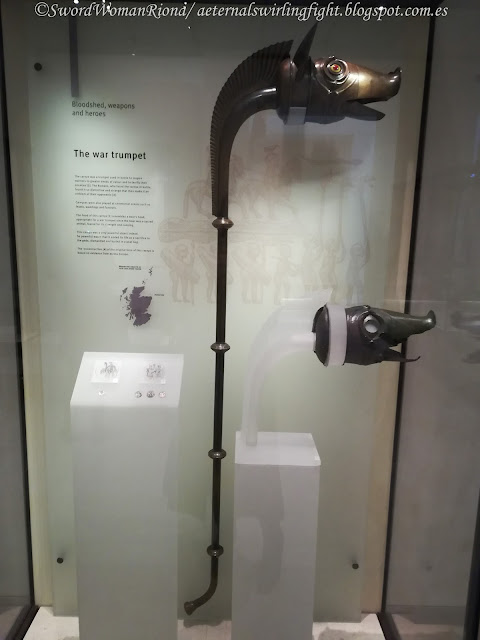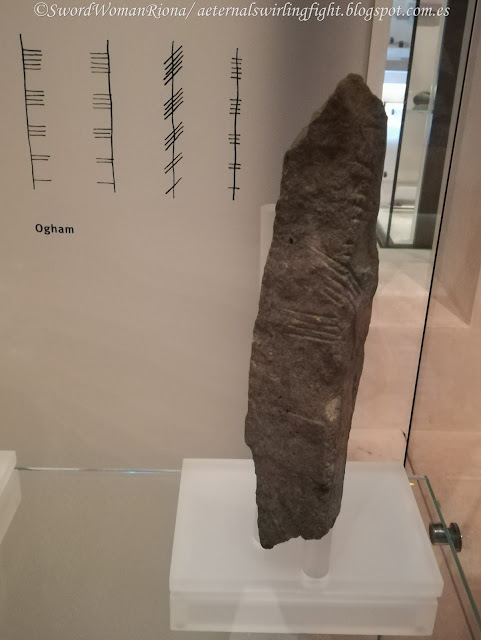This past September I visited Edinburgh's National Museum (National Museum of Scotland), and I really liked the archaeology and Scottish history collection. This is probably the museum I've enjoyed the most alongside the British Museum and the Hallstatt museum - It was really well organized and presented, and included a lot of stuff from some of my favourite cultures. I focused on the 'Early Peoples' exhibit, with Celtic, Pict, Viking and Anglosaxon pieces, spanning from around 8000 BC to AD 1100; and the 'Kingdom of the Scots', from 1100 to 1707.
More info about the pieces either in the signs (click on pics or open in new tab for a bigger size) or linked in descriptions:
- The Galloway Hoard
"Buried at the beginning of the 10th century in Dumfries and Galloway, the Galloway Hoard lay undisturbed for a thousand years before being unearthed by a metal detectorist in September 2014.
This discovery comprises more than 100 objects, including a rich Viking Age hoard of silver jewellery and ingots. It also contains a range of precious metal and jewelled items, including a rare gold ingot, a unique gold bird-shaped pin and a decorated silver-gilt vessel, the only complete lidded vessel of its type ever discovered in Britain and Ireland.
This vessel contains further unusual objects: beads; amulets of glass and rock crystal; a silver penannular brooch; another gold ingot; five Anglo-Saxon disc brooches of a kind not found in Scotland before; and two examples of a new type of quatrefoil brooch. Carefully wrapped in fragile textile bundles are a rock crystal flask or jar and jewelled aestels, pointers used to read and mark places within medieval manuscripts." (Source)
1) 'Early Peoples' (not in chronological order)
- I was lucky to see irl one of my favourite depictions of Brigantia, goddess of the Brigantes (a Britannian tribe) and a warlike version of the Irish goddess Brighid:
"[Brghid's] British and continental counterpart Brigantia seems to have been the Celtic equivalent of the Roman Minerva and the Greek Athena, goddesses with very similar functions and apparently embodying the same concept of elevated state, whether physical or psychological."
(Wikipedia: http://en.wikipedia.org/wiki/Brighid)
Brigantia, the North British warlike version of the Irish Brighid, worshipped mainly by the Brigantes tribe. was equated by the Romans with warlike, lofty goddesses of their own, such as Minerva, goddess of strategical battle, wisdom and crafts, Bellona, the ancient Roman goddess of war, and Victoria, the personified goddess of victory. Roman reliefs of Brigantia show her in depictions heavily influenced by these Classical goddesses, dressed in a long tunic, armed with helmet, spear and shield and carrying a globe of victory in her left hand. The Romans also equated warlike Gaulish goddesses, such as Epona and Belisama, with Minerva.
- Pictish stones
A female aristocrat, Hilton of Cabdoll:
"This hoard of treasure was discovered during excavations on St Ninian’s Isle, Shetland, in 1958. It consists of 28 silver and silver-gilt objects, all decorated, made during the second half of the eighth century. Most of the objects are considered to be Pictish, which means they would have been made and used in the eastern and northern areas of Scotland.
There are twelve brooches in the treasure. In early historic Scotland, brooches such as these did much more than act as cloak fasteners. The size and quality of the decoration signified the wearer’s status and position in society. The number and quality of the brooches found strengthens the suggestion that the treasure came from an aristocratic household." (Source)
"The Deskford carnyx is the head of an Iron Age trumpet. Found in the north-east of Scotland around 1816, it is a masterpiece of early Celtic art, shaped to resemble a wild boar with its upturned snout and decoration mirroring the folds of skin around a boar’s face. It is a complex composite construction, wrought from sheet bronze and brass. This helps us date it, because brass is not native to Scotland: it represents recycled Roman metal. Along with other evidence, this suggests a date between c. AD 80 and 250 for its construction. Today only the head survives: it lacks the erect crest, ears, enamelled eyes, wooden tongue and long cylindrical tube which it once had." (Source)
- Woman's grave, Cnip (875 to 925):
- Anglosaxon loot (1-2); Irish loot/gifts featuring brooches and pins (3-7); Scandinavian personal possessions (8-17):
- Emulating Southern English fashions (2-7) and gift exchanges (8-12):
- Prestige imports (4-10); Irish and Irish-style objects from the 1st millennium AD (11-15)
- Viking sword hilt and other weapons:
- Alphabets: Runes and ogham
- Jewelry and adornments:
- Weapons:
2) 'Kingdom of the Scots' (not in chronological order)
- Queen Mary harp:
"This harp, or clarsach, may have been made in the West Highlands in the 15th century. The woodwork is richly decorated with scroll-work and carvings of animals. (...) This harp was traditionally said to have been given by Mary, Queen of Scots to Beatrix Gardyne of Banchory, while on a hunting trip to Atholl, c. 1563. It is also said to have been adorned at one time with a gold portrait of Mary, which could be the real reason for its association with her. " (Source)
- Pictish stones:
- Scandinavian pieces from Shetland, featuring combs:
"Found on Lewis in 1831, the Lewis Chesspieces are probably the most well-known archaeological find from Scotland. The chesspieces consist of elaborately worked walrus ivory and whales' teeth in the form of seated kings and queens, bishops, knights on their mounts, standing warders and pawns in the shape of obelisks. The hoard is likely to be made up of four chess sets. Eleven pieces are owned by National Museums Scotland and the remaining 82 reside at the British Museum.
Believed to be Scandinavian in origin, the Lewis chesspieces were probably made in Trondheim in Norway during the late 12th and early 13th centuries. At that time, the area in which they were buried was part of the Kingdom of Norway, not Scotland. It is possible that the chesspieces belonged to a merchant travelling from Norway to Ireland, and it seems likely that they were buried for safe keeping en route." (Source)
- Medieval longsowrd (Claymore):
- Cloak rings:









































No comments:
Post a Comment